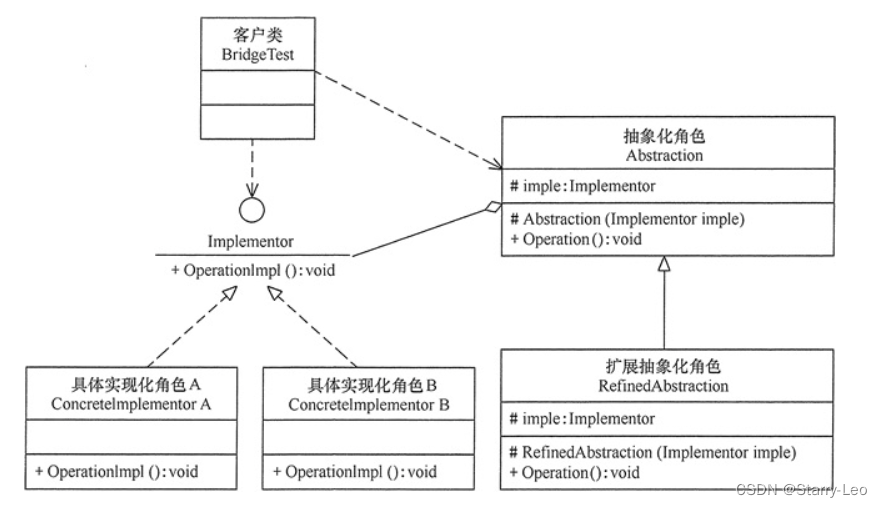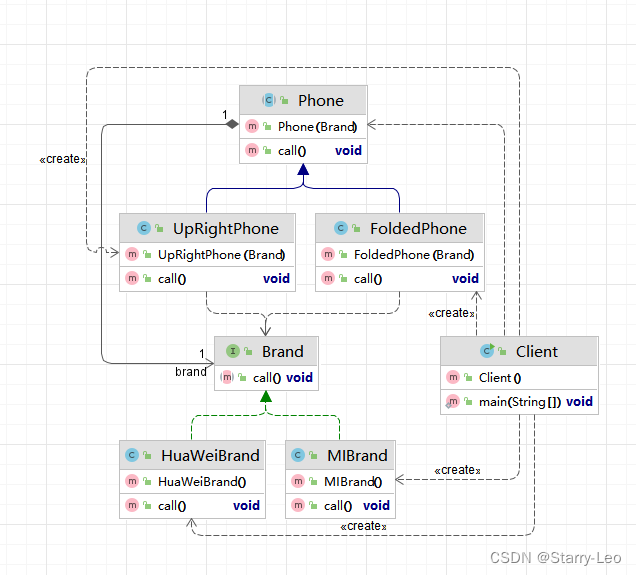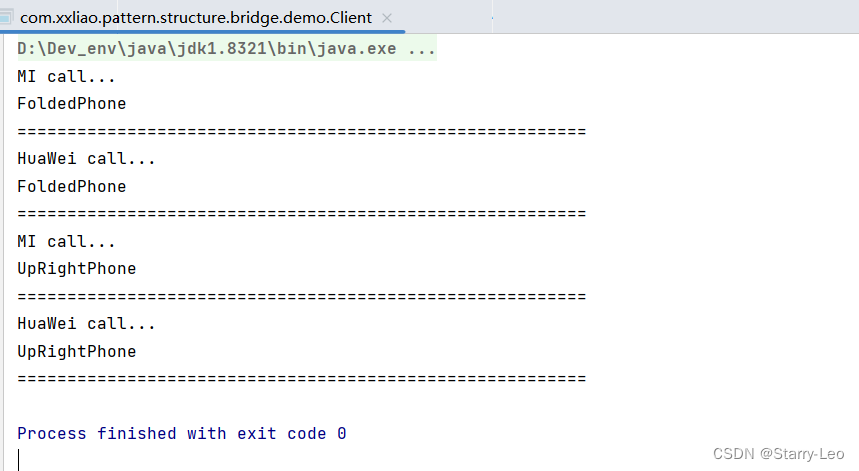桥接模式是一种将抽象 与实现 分离,使它们独立变化。然后利用组合关系来代替继承关系 ,大大的降低了抽象和实现的耦合度 的设计模式。 实际使用: JDBC源码分析,定义了Driver接口,然后各个数据库厂商去实现Driver接口, 1.抽象化角色(Abstraction):定义抽象类,并包含一个对实现化的引用。 2.扩展抽象化角色(Refined Abstraction):抽象化角色的子类,实现父类中的业务方法,并通过组合关系调用实现化角色的业务方法 3.实现化角色(Implementor):定义实现角色的接口,供扩展抽象化角色调用。 4.具体实现化角色(Concrete Implementor):给出实现化接口的具体实现。 1.实现了抽象和实现部分的分离,提高了系统的灵活性,有助于系统进行分层设计。 2.桥接模式替代多层继承方案,可以减少子类的个数,降低系统的管理和维护成本。
package com. xxliao. pattern. structure. bridge. demo ;
public abstract class Phone { private Brand brand; public Phone ( Brand brand) { this . brand = brand; } public void call ( ) { brand. call ( ) ; }
}
package com. xxliao. pattern. structure. bridge. demo ;
public class FoldedPhone extends Phone { public FoldedPhone ( Brand brand) { super ( brand) ; } public void call ( ) { super . call ( ) ; System . out. println ( "FoldedPhone" ) ; }
}
package com. xxliao. pattern. structure. bridge. demo ;
public class UpRightPhone extends Phone { public UpRightPhone ( Brand brand) { super ( brand) ; } public void call ( ) { super . call ( ) ; System . out. println ( "UpRightPhone" ) ; }
}
package com. xxliao. pattern. structure. bridge. demo ; public interface Brand { public abstract void call ( ) ;
}
package com. xxliao. pattern. structure. bridge. demo ;
public class HuaWeiBrand implements Brand { @Override public void call ( ) { System . out. println ( "HuaWei call..." ) ; }
}
package com. xxliao. pattern. structure. bridge. demo ;
public class MIBrand implements Brand { @Override public void call ( ) { System . out. println ( "MI call..." ) ; }
}
package com. xxliao. pattern. structure. bridge. demo ;
public class Client { public static void main ( String [ ] args) { Phone phone1 = new FoldedPhone ( new MIBrand ( ) ) ; phone1. call ( ) ; System . out. println ( "=========================================================" ) ; Phone phone2 = new FoldedPhone ( new HuaWeiBrand ( ) ) ; phone2. call ( ) ; System . out. println ( "=========================================================" ) ; Phone phone3 = new UpRightPhone ( new MIBrand ( ) ) ; phone3. call ( ) ; System . out. println ( "=========================================================" ) ; Phone phone4 = new UpRightPhone ( new HuaWeiBrand ( ) ) ; phone4. call ( ) ; System . out. println ( "=========================================================" ) ; }
}
测试结果 












)

----单级放大器(共源共栅级 Cascode Stage))


)



